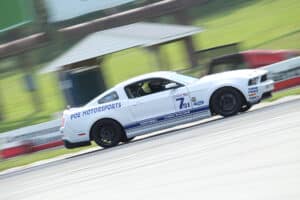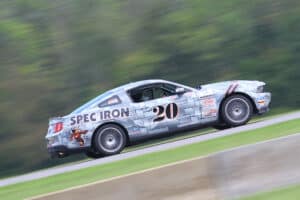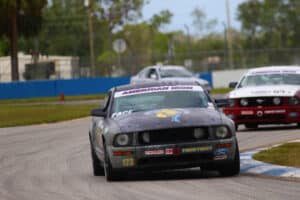
Everything You Wanted to Know About Spec Iron Racing Series
Spec Iron was devised to give late-model Ford Mustang enthusiasts an affordable series in which to race. It represents a step above Camaro-Mustang Challenge and a notch slightly below American Iron, making it a viable go-between offering with all the cost-containment benefits that spec-series racing has to offer. If you’re a die-hard Ford guy, and reliable, affordable racing is appealing to you, Spec Iron might be the series you’ve been looking for.
The American Iron Spec Iron series was created to provide racers with the best value in amateur level road racing by combining the thunder and excitement of American style pony cars with the best possible reliability and durability of the racing platform, thereby minimizing total cost of ownership for racers.
Horsepower — 300 (2005-2009), 315 (2010)
Torque — 320 pound-feet (2005-2009), 325 (2010)
Compression ratio — 9.8:1
Redline — 6,250 rpm
Spec Iron has a strict 11.75:1 horsepower-to-weight ratio and 11.25:1 torque-to-weight ratio limit as measured at the rear wheels. All cars that compete in this class may have less than the specified amount, but may not exceed the 11.75:1 horsepower and 11.25:1 torque ratios.
All Spec Iron participants must have a dynamometer certification report prior to the start of the race or make arrangements to have a dyno test performed immediately after the race.
Tires, size, brand and prices
Spec Toyo Proxes RR 275-35ZR-18, $306 each
Front, with stock calipers; Hawk DTC 60 $219
Rear, with stock calipers; Hawk DTC 60, $177
Check the NASA Contingencies page for the latest programs.
Yes. Ford Performance offers contingency prizes for first through third places at the National Championships, and prize money for regional championships and for regional races.
Ford Performance Contingency Program
Spec Iron is a spec class with the added benefit of dynamometer testing to ensure all cars create no more than 11.75 horsepower per pound of vehicle weight and 11.25 pound-feet of torque per pound. With larger fields on the East Coast and Great Lakes regions, Spec Iron is a close, competitive class, with bumper-to-bumper racing, according to National Series Director Al Watson.
The S197 Mustang comes with reliable engines and transmissions, so consumables are the biggest recurring expense. Tires are good for three race weekends. Front brake pads are good for three or four race weekends and the rears last even longer. Spec Iron cars all have ABS. Oh, and then there is that glorious V8 soundtrack.
The permitted aftermarket Motion Control Suspension shocks are kind of pricey at $2,500 for a set of four, but are a must for a new build.
“It’s one of those things that makes the biggest improvement to your car, so it’s definitely money well spent,” said National Spec Iron Director Al Watson. “It just happens to be a lot of money — but you can’t always get around that in racing.”
Spec Iron Resources
Questions and Answers to Feed Your Curiosity
Latest Spec Iron News Around The Country
Wouldn’t it be great if there were a NASA contingency and Member Benefits partner that offered rewards and discounts on hardcore racing parts we […]
Longtime NASA contingency partner Motion Control Suspension has renewed its contingency program for 2024. One new addition to the program is that […]
As NASA’s official tire retailer, TrackDayTire.com gives NASA members immediate access to an extensive national inventory of Toyo and Hoosier DOT R […]
The 2023 NASA Championships were the culmination of hard work and sacrifice for the drivers who came from across the United States to compete at the […]
NASA Great Lakes racer Bob Collins has just been named as the new National Director for American Iron. Also part of his duties will be leadership of […]
What Spec Iron Competitors Say



Get On-Board with Spec Iron Drivers
Spec Iron Series Contacts